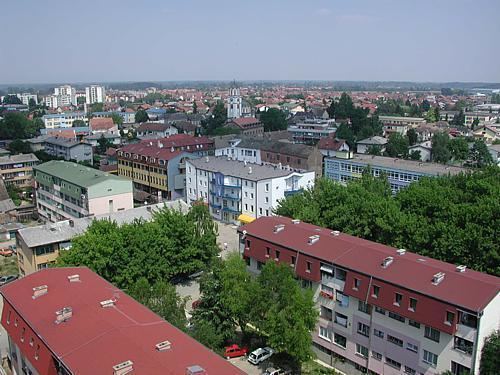Time zone CET (UTC+1) Area 762 km² | Elevation 163 m (535 ft) Postal code 78400 Local time Saturday 1:21 AM | |
 | ||
Weather 7°C, Wind W at 8 km/h, 79% Humidity | ||
Bosanska Gradiška (Serbian Cyrillic: Градишка) is a town and municipality in northwestern Bosnia and Herzegovina, part of the Republika Srpska entity. The municipality is geographically located in eastern Krajina region, and the town is situated on the Lijevče plain, on the right bank of the Sava river across from Stara Gradiška, Croatia, and about 40 km (25 mi) north of Banja Luka.
Contents
- Map of GradiC5A1ka Bosnia and Herzegovina
- History
- Culture
- Demographics
- Settlements
- Notable residents
- Twin towns Sister cities
- References
Map of Gradi%C5%A1ka, Bosnia and Herzegovina
History
In the Roman period, the municipium of Serbinum existed on the location of the present-day town. It was of strategic importance; a port of the Roman fleet was situated here. Among notable archaeological findings are a viaduct.
Gradiški Brod is mentioned for the first time as a town in c. 1330. It had a major importance as the location where the Sava river used to be crossed. By 1537, the town and its surroundings came under Ottoman rule.
The Ottoman built a fortress, which served as the Bosnia Eyalet's northern defense line. The town was also called Berbir because of the fortress.
Following the outbreak of the First Serbian Uprising (1804), in the Sanjak of Smederevo (modern Central Serbia), the Jančić's Revolt broke out in the Gradiška region against the Ottoman government in the Bosnia Eyalet, following the erosion of the economic, national and religious rights of Serbs. Hajduks also arrived from Serbia, and were especially active on the Kozara. Jovan Jančić Sarajlija organized the uprising with help from Metropolitan Benedikt Kraljević. The peasants took up arms on 23 September 1809, in the region of Gradiška, beginning from Mašići. The fighting began on 25 September, and on the same night, the Ottomans captured and executed Jančić. The rebels retreated to their villages, except those in Kozara and Motajica who continued, and offered strong resistance until their defeat in mid-October, after extensive looting and burning of villages by the Ottomans. Another revolt broke out in 1834, in Mašići.
Ottoman rule ended with the Austro-Hungarian occupation of Bosnia and Herzegovina (1878), following the Herzegovina Uprising (1875–77). Austro-Hungarian rule in Bosnia and Herzegovina ended in 1918, when the South Slavic Austro-Hungarian territories proclaimed the State of Slovenes, Croats and Serbs, which subsequently joined the Kingdom of Serbia into the Kingdom of Yugoslavia.
From 1929 to 1941 Gradiška was part of the Vrbas Banovina of the Kingdom of Yugoslavia.
During Yugoslavia, the town was known as Bosanska Gradiška. During the Bosnian War, the town was incorporated into Republika Srpska (RS). After the war, the RS National Assembly changed the name, omitting bosanska ("Bosnian"), as was done with many other towns (Kostajnica, Dubica, Novi Grad, Petrovo, Šamac).
Culture
The town has a Serbian Orthodox cathedral dedicated to the Mother of God.
Demographics
The ethnic composition of the municipality:
Settlements
The municipality includes total of 75 settlements:
